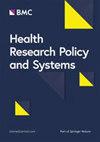采用、实施和吸收涉及结构性弱势群体的共同生产的医疗和社会护理创新:加拿大、苏格兰和瑞典纵向多案例研究设计的结果
IF 3.6
2区 医学
Q1 HEALTH POLICY & SERVICES
引用次数: 0
摘要
在世界各地的不同环境中,共同制作方面的创新正在影响着公共服务改革。尽管许多创新都是地方性的,但其他创新也随着时间的推移而扩大和演变。然而,我们对共同制作的实施和演变过程知之甚少。本研究旨在探讨与结构性弱势群体共同生产公共服务的三种方法的采用、实施和吸收情况。我们对涉及弱势群体的三种共同生产公共服务创新进行了为期四年(2019-2023 年)的纵向多案例研究:瑞典延雪平地区的 ESTHER,涉及有多种复杂需求的人群(案例 1);苏格兰邓迪的 "让康复成为现实",涉及严重精神疾病患者(案例 2);加拿大马尼托巴省的学习中心(案例 3),同样涉及严重精神疾病患者。数据来源包括与战略决策者进行的 14 次访谈,以及为了解与每个案例相关的历史和背景因素而进行的文件分析。案例研究方案、半结构化访谈指南、数据提取、演绎编码和分析均参考了三个框架:实施研究综合框架、创新扩散模型和洛佐的兼容性差距,以了解同化情况。在案例 1 和 3 中,涉及结构性弱势人群的共同生产是现有改进工作的显著发展,而在案例 2 中,外部变革机构的推动、社区组织之间现有的合作努力以及为新的市政心理健康政策提供信息的机会,都激发了共同生产的采用。在所有案例中,共同生产创新都围绕着一个核心理念,即在共同生产过程中,生活经验与专业知识同等重要。这种哲学取向提供了灵活性和对当地情况的适应性,因此与更明确的计划相比更便于实施。根据信息提供者的说法,为避免同化风险所做的努力取得了成功,从而吸收了新的思维 方式和共同制作过程,并举例说明了这是如何带来变革的。在探索与结构性弱势群体共同生产的创新过程中,我们的研究结果表明,在应用现有理论框架时,还需要考虑一些其他因素。其中包括创新的哲学性质、研究创新本身随着时间推移而产生的演变的必要性、更加关注作为现有权力结构破坏者的合作过程,以及对推动组织文化转型变革的重视。本文章由计算机程序翻译,如有差异,请以英文原文为准。
Adopting, implementing and assimilating coproduced health and social care innovations involving structurally vulnerable populations: findings from a longitudinal, multiple case study design in Canada, Scotland and Sweden
Innovations in coproduction are shaping public service reform in diverse contexts around the world. Although many innovations are local, others have expanded and evolved over time. We know very little, however, about the process of implementation and evolution of coproduction. The purpose of this study was to explore the adoption, implementation and assimilation of three approaches to the coproduction of public services with structurally vulnerable groups. We conducted a 4 year longitudinal multiple case study (2019–2023) of three coproduced public service innovations involving vulnerable populations: ESTHER in Jönköping Region, Sweden involving people with multiple complex needs (Case 1); Making Recovery Real in Dundee, Scotland with people who have serious mental illness (Case 2); and Learning Centres in Manitoba, Canada (Case 3), also involving people with serious mental illness. Data sources included 14 interviews with strategic decision-makers and a document analysis to understand the history and contextual factors relating to each case. Three frameworks informed the case study protocol, semi-structured interview guides, data extraction, deductive coding and analysis: the Consolidated Framework for Implementation Research, the Diffusion of Innovation model and Lozeau’s Compatibility Gaps to understand assimilation. The adoption of coproduction involving structurally vulnerable populations was a notable evolution of existing improvement efforts in Cases 1 and 3, while impetus by an external change agency, existing collaborative efforts among community organizations, and the opportunity to inform a new municipal mental health policy sparked adoption in Case 2. In all cases, coproduced innovation centred around a central philosophy that valued lived experience on an equal basis with professional knowledge in coproduction processes. This philosophical orientation offered flexibility and adaptability to local contexts, thereby facilitating implementation when compared with more defined programming. According to the informants, efforts to avoid co-optation risks were successful, resulting in the assimilation of new mindsets and coproduction processes, with examples of how this had led to transformative change. In exploring innovations in coproduction with structurally vulnerable groups, our findings suggest several additional considerations when applying existing theoretical frameworks. These include the philosophical nature of the innovation, the need to study the evolution of the innovation itself as it emerges over time, greater attention to partnered processes as disruptors to existing power structures and an emphasis on driving transformational change in organizational cultures.
求助全文
通过发布文献求助,成功后即可免费获取论文全文。
去求助
来源期刊

Health Research Policy and Systems
HEALTH POLICY & SERVICES-
CiteScore
7.50
自引率
7.50%
发文量
124
审稿时长
27 weeks
期刊介绍:
Health Research Policy and Systems is an Open Access, peer-reviewed, online journal that aims to provide a platform for the global research community to share their views, findings, insights and successes. Health Research Policy and Systems considers manuscripts that investigate the role of evidence-based health policy and health research systems in ensuring the efficient utilization and application of knowledge to improve health and health equity, especially in developing countries. Research is the foundation for improvements in public health. The problem is that people involved in different areas of research, together with managers and administrators in charge of research entities, do not communicate sufficiently with each other.
 求助内容:
求助内容: 应助结果提醒方式:
应助结果提醒方式:


